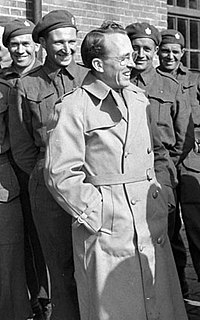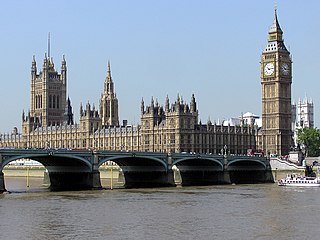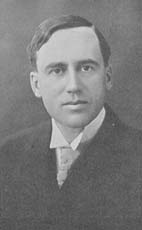The campaign
The Co-operative Commonwealth Federation government of Tommy Douglas lost a significant share of the popular vote, and 6 of the seats it had won in the 1952 election; but retained its majority in the legislature, winning a fourth term in office.

Thomas Clement Douglas was a Canadian politician who served as Premier of Saskatchewan from 1944 to 1961 and Leader of the New Democratic Party from 1961 to 1971. A Baptist minister, he was elected to the House of Commons of Canada in 1935 as a member of the Co-operative Commonwealth Federation (CCF). He left federal politics to become Leader of the Saskatchewan Co-operative Commonwealth Federation and then the seventh Premier of Saskatchewan. His cabinet was the first social democrat government in North America and it introduced the continent's first single-payer, universal health care program.
The Liberal Party of Alexander H. McDonald also lost votes, but picked up an additional three seats.
The Social Credit Party of Saskatchewan rebounded from its poor results in previous elections to win over 21% of the popular vote. Because this was spread out across the province, however, the party won only 3 seats in the legislature under the British parliamentary first-past-the-post system.
The Social Credit Party of Saskatchewan was a political party in the Canadian province of Saskatchewan that promoted social credit economic theories from the mid-1930s to the mid-1970s.

The Westminster system is a parliamentary system of government developed in the United Kingdom. This term comes from the Palace of Westminster, the seat of the British Parliament. The system is a series of procedures for operating a legislature. It is used, or was once used, in the national legislatures and subnational legislatures of most former British Empire colonies upon gaining responsible government, beginning with the first of the Canadian provinces in 1848 and the six Australian colonies between 1855 and 1890. However, some former colonies have since adopted either the presidential system or a hybrid system as their form of government.

A first-past-the-post electoral system is one in which voters indicate on a ballot the candidate of their choice, and the candidate who receives the most votes wins. This is sometimes described as winner takes all. First-past-the-post voting is a plurality voting method. FPTP is a common, but not universal, feature of electoral systems with single-member electoral divisions, and is practiced in close to one third of countries. Notable examples include Canada, India, the United Kingdom, and the United States, as well as most of their current or former colonies and protectorates.

The Progressive Conservative Party of Saskatchewan is a right-of-centre political party in the Canadian province of Saskatchewan. Prior to 1942, it was known as the Conservative Party of Saskatchewan. Members are commonly known as Tories.

The British Columbia general election of 1996 was the thirty sixth provincial election in the Province of British Columbia, Canada. It was held to elect members of the Legislative Assembly of British Columbia. The election was called on April 30, 1996, and held on May 28, 1996. Voter turnout was 59.1 per cent of all eligible voters. The election is notable for producing a "false-winner" outcome, rewarding a party that got second in the popular vote with a majority government.

The Saskatchewan general election of 1912 was the third provincial election in the Canadian province of Saskatchewan. It was held on July 11, 1912 to elect members of the Legislative Assembly of Saskatchewan. Premier Walter Scott led the Liberal Party of Saskatchewan to a third term in office with a significant increase in the share of the popular vote. The opposition, now renamed from the Provincial Rights Party to the Conservative Party of Saskatchewan and led by Wellington Bartley Willoughby, lost both votes and seats in the legislature.

The Saskatchewan general election of 1917 was the fourth provincial election in the Canadian province of Saskatchewan. It was held on June 26, 1917, to elect members of the Legislative Assembly of Saskatchewan.

The Saskatchewan general election of 1921 was the fifth provincial election held in the Canadian province of Saskatchewan. It was held on June 9, 1921 to elect members of the Legislative Assembly of Saskatchewan.

The Saskatchewan general election of 1929 was the seventh provincial election held in the Canadian province of Saskatchewan. It was held on June 6, 1929 to elect members of the Legislative Assembly of Saskatchewan.

The Saskatchewan general election of 1934 was the eighth provincial election held in the Canadian province of Saskatchewan. It was held on June 19, 1934, to elect members of the Legislative Assembly of Saskatchewan.

The Saskatchewan general election of 1938 was the ninth provincial election held in the Canadian province of Saskatchewan. It was held on June 8, 1938, to elect members of the Legislative Assembly of Saskatchewan.

The Saskatchewan general election of 1944 was the tenth provincial election in the Canadian province of Saskatchewan. It was held on June 15, 1944 to elect members of the Legislative Assembly of Saskatchewan.

The Saskatchewan general election of 1948 was the eleventh provincial election held in the Canadian province of Saskatchewan. It was held on June 24, 1948, to elect members of the Legislative Assembly of Saskatchewan.

The Saskatchewan general election of 1952 was the twelfth provincial election held in the Canadian province of Saskatchewan. It was held on June 11, 1952, to elect members of the Legislative Assembly of Saskatchewan.

The Saskatchewan general election of 1967 was the sixteenth provincial election held in the Canadian province of Saskatchewan. It was held on October 11, 1967, to elect members of the Legislative Assembly of Saskatchewan.

The Saskatchewan general election of 1971 was the seventeenth provincial election in the Canadian province of Saskatchewan. It was held on June 23, 1971, to elect members of the Legislative Assembly of Saskatchewan.

The Saskatchewan general election of 1978 was the nineteenth provincial election in the Canadian province of Saskatchewan. It was held on October 18, 1978, to elect members of the Legislative Assembly of Saskatchewan.

The Saskatchewan general election of 1982 was the twentieth provincial election held in the Canadian province of Saskatchewan. It was held on April 26, 1982, to elect members of the Legislative Assembly of Saskatchewan.

The Saskatchewan general election of 1991 was the twenty-second provincial election held in the Canadian province of Saskatchewan. It was held on October 21, 1991, to elect members of the Legislative Assembly of Saskatchewan.

The Saskatchewan general election of 1999 was the twenty-fourth provincial election held in the Canadian province of Saskatchewan. It was held on September 16, 1999 to elect members of the 24th Legislative Assembly of Saskatchewan.

The British Columbia general election of 1956 was the 25th general election in the Province of British Columbia, Canada. It was held to elect members of the Legislative Assembly of British Columbia. The election was called on August 13, 1956, and held on September 19, 1956. The new legislature met for the first time on February 7, 1957.

The 27th Saskatchewan general election was held on November 7, 2011, to elect 58 members of the Legislative Assembly of Saskatchewan (MLAs). The election was called on October 10 by the Lieutenant Governor of Saskatchewan, on the advice of Premier Brad Wall. Wall's Saskatchewan Party government was re-elected with an increased majority of 49 seats, the third-largest majority government in the province's history. The opposition New Democratic Party was cut down to only nine ridings, its worst showing in almost 30 years.


















